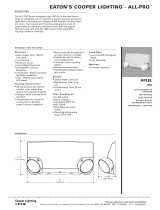
10 OPERATION AND INSTALLATION INSTRUCTIONS MN280075EN July 2018
Form 6 microprocessor-based rack-mount recloser control
Over and Underfrequency
Trip Signal Issued
Close Signal Issued
Removable inserts
Removable inserts are included with the control design
for customization of specific protection requirements.
Inserts are available for the status indicator LEDs, the
operator panel function keys, and the analysis keys.
The removable inserts are designed for use without
adhesives, labelmakers, or temporary labels. Refer to
Using removable inserts section in this manual for more
information.
An electronic label template is included on the ProView
application software CD and can be accessed through the
following default address: C: / Program Files / Cooper /
ProviewXX / Form6 / Form 6 Inserts.doc
Idea workbench
The Idea Workbench provides access to various inputs,
intermediate variables, and internal Form 6 alarms, status,
and targets to allow user-customization of the Form 6
recloser control to meet specific and unique applications.
Idea Workbench also gives the user the ability to perform
logical functions with these variables by using a simple
graphical user interface. Use of Idea Workbench is not a
requirement for operation.
Refer to Service Information S280-70-4 (ProView 4.X.X) or
S280-70-21 (ProView 5.X.X) Form 6 Control Programming
Guide for additional Idea Workbench information.
Over/underfrequency protection
The control includes two-stage operation for both
underfrequency and overfrequency protection. A fixed
time delay ranging from 0 to 100 seconds in .001 second
increments is available for both over and underfrequency.
A frequency restoration function, enabled or disabled by
the user, is provided to allow the recloser to automatically
close should frequency return to within configured settings
for a user-settable time. Over/Underfrequency Protection is
included as part of each protection profile.
Over/undervoltage protection
The control includes single-phase and three-phase
undervoltage tripping. The control also includes three-phase
overvoltage tripping. Both over and undervoltage functions
include a single-phase and three-phase pick-up setting; a
single-phase and three-phase time delay setting ranging
from 0 to 100 seconds.
Directional
Directional functionality is included to maintain system
coordination from multiple sources, as well as circuit
reconfiguration for each profile. Directional applies to
phase, ground, and negative sequence protection, selected
independently. A maximum torque angle has a range of
0 – 90 degrees.
Fault location
The control includes an impedance-based fault locator
based upon the Takagi algorithm
1
. Load-compensated
impedance calculation is used for calculating the distance.
Positive and zero sequence is configured in ohms, and the
fault locator line length is configured in kilometers/miles.
1
T. Takagi, Y. Yamakoshi, J. Baba, K. Uemura, T. Sakaguchi,
“A New Algorithm of an Accurate Fault Location for EHV/
UHV Transmission Lines: Part I - Fourier Transformation
Method”, IEEE Trans. on PAS, Vol. PAS-100, No. 3,
March1981, pp1316-1323.
Sync check
Sync Check is a permissive system used to qualify any
close signal to the mechanism when enabled via the
sync check settings. Sync check allows for closing for
any combination of dead/live bus/line, and to perform
anticipatory closing for a live bus/live line condition by
calculating slip and anticipating the mechanism closing
delay. In addition to the anticipatory close calculation, the
sync check system performs verification of line and bus
voltage magnitudes and frequencies to determine that they
are within pre-determined ranges, and that the angular
difference between the two systems is also within the
pre-determined range. For a live/live close, where there
is no slip between the systems, the sync check system
allows permissive closing after the two systems are within
frequency and voltage limits, and the angular difference
between the systems has been within the allowable limits
for a pre-determined time.
Sync Check functionality includes the following applications:
Hot Line/Hot Bus Closing; Dead Line/Hot Bus Closing; Hot
Line/Dead Bus Closing; and Dead Line/Dead Bus Closing.
Sync Check Parameters include the following configurable
settings: Voltage Angle; Mechanism Operating Delay; Static
Angle Delay; Dead Threshold; Live Threshold; Positive
Sequence Dead Threshold; Upper Voltage Limit; Lower
Voltage Limit; Lower Frequency Limit; Upper Frequency
Limit; and Fail to Close Timer.
Data profiler
A fully-configurable data profiler is available which allows the
user to collect information by sampling data at selectable
intervals. These time-stamped values can then be viewed to
determine weekly load profiles, daily harmonic disturbances
or hourly voltage fluctuations. The number of days of
information the data profiler can provide depends upon
configuration parameters.
Refer to Service Information S280-70-4 (ProView 4.X.X) or
S280-70-21 (ProView 5.X.X) Form 6 Control Programming
Guide for additional information.




















